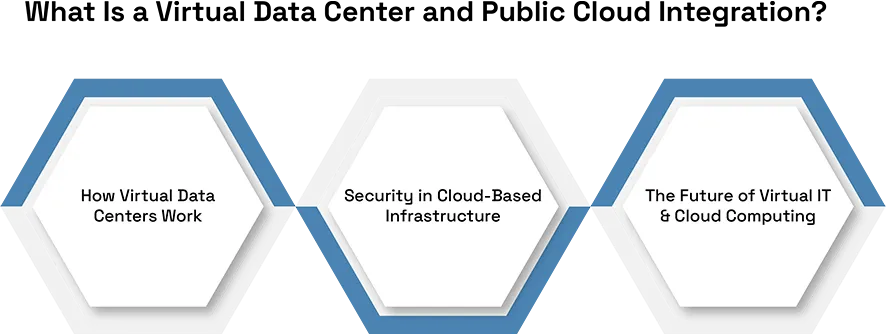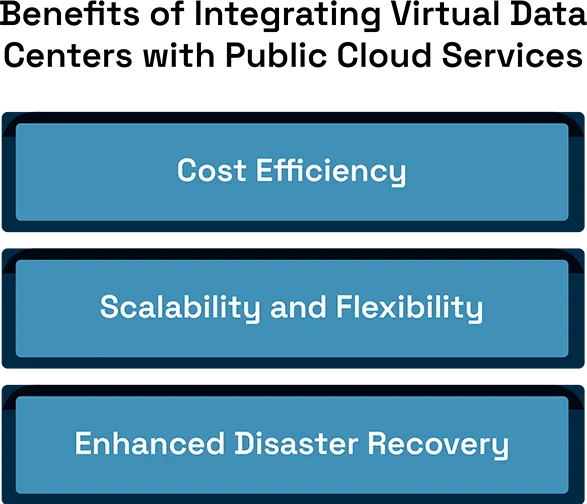In 2025, synchronizing Virtual Data Centers (VDCs) with public cloud services has become a strategic move that has made various enterprises seek flexibility and scalability. It helps an organization connect its outside framework to the cloud; thus, it takes a blend of private and public cloud systems. In this way organizational members can distribute resources flexibly, schedule work intakes effectively, and adapt to fluctuations in customer requirements. There is a need for agility in the company’s operation and the aversion towards lock-in contracts which makes companies free to choose the most appropriate service from various suppliers.
Recent developments underscore this trend. For instance, today’s Cloud Foundation by VMware has improved its license portability which will enable organizations to run workloads across different environments, such as the public cloud. Such flexibility is useful in expanding organizational operations and putting in place sound disaster recovery strategies. Also, the investments by market giants, including the €7.8 billion that Amazon recently dedicated to German cloud facilities, prove that localized cloud services that meet the requirements of the data sovereignty laws are the new focus. Combined, these indicate that businesses are moving towards more integrated and flexible IT environments capable of supporting companies in the future of the digital environment in 2025 and beyond.
What Is a Virtual Data Center and Public Cloud Integration?
A virtual data center (VDC) refers to a set of IT resources that are hosted on the internet and that deliver the services that an actual physical data center offers. In particular, a VDC is based on virtual machines, storage, and networking residing in cloud environments. This way of business helps businesses to run the IT environment of the business without much physical investment in equipment.
Public Cloud Integration can be defined as the process of engaging these elastic virtual data centers with the public cloud services available in Amazon Web Services (AWS), Microsoft Azure, or Google Cloud. This integration allows an organization to expand IT services in an ‘outsourced’ environment, extending control of the VDC with the capacity of public cloud environments.

How Does Integration Work Between Virtual Data Centers and Public Clouds?
A VDC needs to connect with the public cloud services, mostly through direct links between the virtual infrastructure and the public cloud providers. It can be accomplished with the help of networks such as a Virtual Private Network (VPN) or dedicated ones like AWS Direct Connect. Such connections allow data to be transferred between the two environments securely and effectively.
Furthermore, many organizations may also employ a hybrid cloud solution to practice the management of resources within both public and private clouds. These tools offer a combined control plane for assigning workloads, installing applications, and guaranteeing that an integration runs seamlessly and fulfills business norms.
Why Is Integration Becoming Essential in Modern IT Infrastructure?
Flexibility and rapidly growing IT structures in the business environment are crucial for today’s generation. Through the integration of VDCs to public cloud services, organizations can easily adapt to consumer needs without having to invest a lot of money in physical resources. This is flexibility, which is very important in determining the capacity to grow and be innovative.
Thirdly, with an increase in decentralized workforce services, the dual system helps retain a connection to company resources, increasing productivity and efficiency. This integration also bears the benefit of disaster recovery because the systems and data are maintained in the cloud to prevent loss.
Benefits of Integrating Virtual Data Centers with Public Cloud Services
Cost Efficiency: This is a way through which firms can cut costs associated with purchasing and maintaining infrastructure locally. Another advantage that is worth sharing is associated with the pricing of the public clouds often described as pay-as-you-go, hence organizations only have to pay for the utilization of the resources consumed.
Scalability and Flexibility: Integration helps an organization to avail more IT resources than it requires or reduce the extent of IT resources that are necessary. It also means that firms can scale up or down depending on the demand that they can receive without having to overbook or underbook for capacity.
Enhanced Disaster Recovery: The replication of data and applications helps business to quickly restore their operations in case of an adverse occurrence of any event. This redundancy reduces one’s downtime and thus increases his uptime.
Improved Performance: The organization was also of the view that load distribution, both at VDC and public cloud levels is effective as it enables several tasks to be run at the most appropriate environment based on among others considerations such as latency and availability of resources.
Simplified Management: Unified management tools provide a centralized platform to monitor and control resources across both environments, streamlining operations and reducing administrative overhead.

Real-World Example: How VMware and AWS Collaborate for Hybrid Cloud Integration
Amazon Web Services VMware Cloud on AWS is a solution from both companies that applies VMware software-defined data centers on scalable AWS infrastructure. This means that businesses could operate the VMware workload directly on AWS and thus create a unified hybrid cloud environment.
For instance, through its business, VMware Cloud on AWS helps Expedia Group, a global travel platform increase data center facilities and improve disaster recovery. That way Expedia was able to obtain flexibility and highly available IT, which provided enhanced service support to users across the globe when Catapult’s VDC was integrated into AWS.








